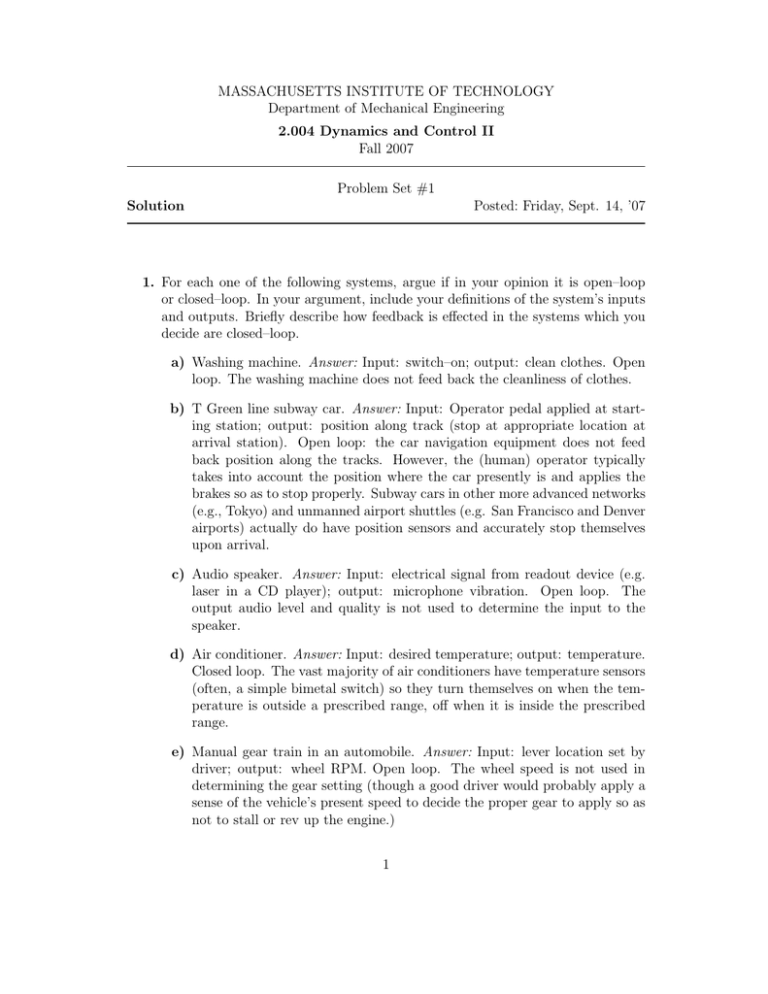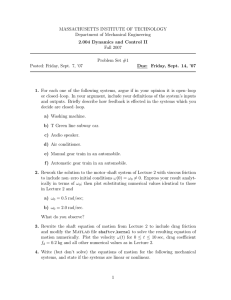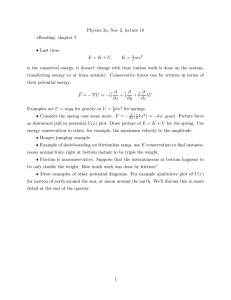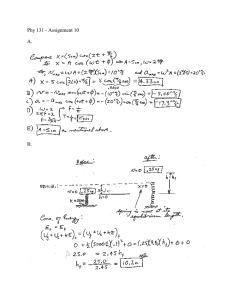Document 13664349
advertisement

MASSACHUSETTS INSTITUTE OF TECHNOLOGY Department of Mechanical Engineering 2.004 Dynamics and Control II Fall 2007 Problem Set #1 Posted: Friday, Sept. 14, ’07 Solution 1. For each one of the following systems, argue if in your opinion it is open–loop or closed–loop. In your argument, include your definitions of the system’s inputs and outputs. Briefly describe how feedback is effected in the systems which you decide are closed–loop. a) Washing machine. Answer: Input: switch–on; output: clean clothes. Open loop. The washing machine does not feed back the cleanliness of clothes. b) T Green line subway car. Answer: Input: Operator pedal applied at start­ ing station; output: position along track (stop at appropriate location at arrival station). Open loop: the car navigation equipment does not feed back position along the tracks. However, the (human) operator typically takes into account the position where the car presently is and applies the brakes so as to stop properly. Subway cars in other more advanced networks (e.g., Tokyo) and unmanned airport shuttles (e.g. San Francisco and Denver airports) actually do have position sensors and accurately stop themselves upon arrival. c) Audio speaker. Answer: Input: electrical signal from readout device (e.g. laser in a CD player); output: microphone vibration. Open loop. The output audio level and quality is not used to determine the input to the speaker. d) Air conditioner. Answer: Input: desired temperature; output: temperature. Closed loop. The vast majority of air conditioners have temperature sensors (often, a simple bimetal switch) so they turn themselves on when the tem­ perature is outside a prescribed range, off when it is inside the prescribed range. e) Manual gear train in an automobile. Answer: Input: lever location set by driver; output: wheel RPM. Open loop. The wheel speed is not used in determining the gear setting (though a good driver would probably apply a sense of the vehicle’s present speed to decide the proper gear to apply so as not to stall or rev up the engine.) 1 f ) Automatic gear train in an automobile. Answer: Unlike the manual gear­ box, in the automatic gearbox (as the name implies!) there is a feedback mechanism: the wheel RPM heats up a special fluid causing it to expand or contract. The engine gear ratio is changed due to the fluid volume change. 2. Rework the solution to the motor–shaft system of Lecture 2 with viscous friction to include non–zero initial conditions ω(0) = ω0 = 0. Express your result analyt­ ically in terms of ω0 ; then plot substituting numerical values identical to those in Lecture 2 and a) ω0 = 0.5 rad/sec; b) ω0 = 2.0 rad/sec. What do you observe? Answer: ω(0) = ω0 = A + �� T0 � 1 − e−t/τ �t=0 b ⇒ A = ω0 − T0 . b The complete solution is then ω(t) = ω0 e−t/τ + � T0 � 1 − e−t/τ . b The results are plotted below. a) ω0 = 0.5 rad/sec. ω(t) [rad/sec] 1 0.632 0 0 2 4 6 t [sec] b) ω0 = 2.0 rad/sec. 2 8 10 ω(t) [rad/sec] 2 1 0.632 0 0 2 4 6 8 10 t [sec] We observe that in the first case [ω0 < ω(∞)] the response “spins up” to the steady–state from the initial condition, where in the second case [ω0 > ω(∞)] the response “spins down” to the steady–state from the initial condition. 3. Rewrite the shaft equation of motion from Lecture 2 to include drag friction and modify the Matlab file shaftcv kernel to solve the resulting equation of motion numerically. Plot the velocity ω(t) for 0 ≤ t ≤ 10 sec, drag coefficient fd = 0.2 kg and all other numerical values as in Lecture 2. Answer: Since drag friction is fd |ω|ω, the equation of motion is written as dω(t) + bω(t) + fv ω(t) + fc sgn(ω(t)) + fd |ω(t)|ω(t) = Ts (t). dt ω(t) [rad/sec] J 0.9 0.567 0 0 2 4 6 8 10 t [sec] 4. Write (but don’t solve) the equations of motion for the following mechanical systems, and state if the systems are linear or nonlinear. a) An inertia J of radius r attached to a fixed axis of rotation A as shown below. 3 The inertia is in contact with a mass M attached via a spring of stiffness K to a fixed wall. The inertia–mass contact is subject to viscous friction of coefficient fv . The motion of the mass with respect to the horizontal floor is subject to the same viscous friction coefficient fv . The system input is a horizontal force f (t) on the mass M and the output is the rotation θ(t) of the inertia. θ J r A fv K f(t) M fv Answer: You have one input f (t) and two outputs x(t) and θ(t), which are related to each other. Unlike rolling with no-slipping problem in dynamics class, you have to consider slipping because viscous friction happens when the relative velocity at the interface of two surface is non–zero. Free–body diagram of the mass: Free–body diagram of the inertia: The viscous friction between the mass and inertia is proportional to the relative velocity (ẋ−rθ̇). From free–body diagrams, the equations of motion are M ẍ(t) + 2fv ẋ(t) + Kx(t) − fv rθ̇(t) = f (t), and Jθ̈(t) + r2 fv θ̇(t) − rfv ẋ(t) = 0. If you want to obtain the relation of single input f (t) and single output x(t), then you can eliminate x(t) and combine the above two equations. From 4 the second equation, ẋ(t) = J θ̈(t) + rθ̇(t). rfv ... This implies ẍ(t) = rfJv θ (t) + rθ̈(t) and x = rfJv θ̇(t) + rθ(t). (Zero–initial condition is assumed. If not, there is only offset θ0 and it doesn’t make any difference physically.) Using those relations, the equation of motion can be simplified to � � � � ... JM θ (t) + fv r2 M + 2J θ̈(t) + fv2 r2 + KJ θ̇(t) + Kr2 fv θ(t) = fv rf (t). ... It is a linear differential equation because it has only θ(t), θ̇(t), θ̈(t), and θ (t) terms. b) A pendulum consisting of a mass m attached to a rigid mass–less rod as shown below. The system input is a horizontal external force and the output is the angle θ. external force (input) m θ gravity Answer: From force balance, you can derive the equation of motion. For simplicity, the system variable θ(t) is chosen with polar coordinates. Then you don’t need to care about tension on the rod and centrifugal force. Free–body diagram: Assuming that the length of the rod is l, we obtain ml2 θ̈(t) − mgl sin θ(t) = f (t)l cos θ(t). 5 Note that inertia of the mass with respect to the rotation axis is ml2 . It is a non linear differential equation because it has sin θ(t) term. If θ(t) is small enough to be assumed sin θ(t) ∼ θ(t) and cos θ(t) ∼ 1, then ¨ − mgθ(t) = f (t) (probably we have seen in it is linear equation as mlθ(t) physics class). 5. Given below are the equations of motion for several systems. f (t) denotes the external force (i.e., input). Which of these systems are linear? Include a brief justification based on the definition of linear systems from Lecture 1. � � a) 7ẍ + 0.5ẋ + 5 sin 210π t x = f (t). Answer: Linear If the differential equation is linear and two functions x1 (t) and x2 (t) are satisfied with � � 2π 7x¨1 + 0.5x˙1 + 5 sin t x1 = f1 (t) and 10 � � 2π t x2 = f2 (t), 7x¨2 + 0.5x˙2 + 5 sin 10 then x1 + x2 also should be the solution of the differential equation with the input f1 (t) + f2 (t), which is true because � � 2π 7(x¨1 + x¨2 ) + 0.5(x˙1 + x˙2 ) + 5 sin t (x1 + x2 ) = f1 (t) + f2 (t). 10 b) 7ẍ + 0.5ẋ + 5(1 + 0.1x)x = f (t). Answer: Non–linear With the same method as a), the two functions x1 (t) and x2 (t) are the solutions of 7x¨1 + 0.5x˙1 + 5(1 + 0.1x1 )x1 = f1 (t) and 7x¨2 + 0.5x˙2 + 5(1 + 0.1x2 )x2 = f2 (t). However, x1 + x2 is not the solution of the differential equation with the input f1 (t) + f2 (t) because 7(x¨1 + x¨2 ) + 0.5(x˙1 + x˙2 ) + 5(1 + 0.1x1 )x1 + 5(1 + 0.1x2 )x2 = 7(x¨1 + x¨2 ) + 0.5(x˙1 + x˙2 ) + 5(1 + 0.1(x1 + x2 ))(x1 + x2 ). c) d dt �1 2 � mẋ2 + 12 kx2 = 0. Answer: Linear You can solve either way: 1) By taking derivative first and inspecting. d dt � 1 1 mẋ2 + kx2 2 2 6 � = mẋ (mẍ + kx) = 0. If we assume x˙ = 0, then the equation is linear. (The reason why the assumption is valid, if ẋ = 0 then x = const. and trivial.) 2) With the same method, we have two functions x1 and x2 satisfied with � � 1 2 d 1 2 mx˙1 + kx1 = 0, and dt 2 2 � � d 1 1 2 2 mx˙2 + kx2 = 0. dt 2 2 From the first equation, and again assuming ẋ1 = 0, ẋ2 = 0 for non–trivial solution, mẍ1 + kx1 = 0. From the second equation mẍ2 + kx2 = 0. Now consider � � 1 d 1 2 2 m(ẋ1 + ẋ2 ) + (x1 + x2 ) dt 2 2 � � d 1 2 1 2 2 2 = (ẋ + ẋ2 + 2ẋ1 ẋ2 ) + (x1 + x2 + 2x1 x2 ) dt 2 1 2 = m (ẋ1 ẍ1 + ẋ2 ẍ2 + ẋ1 ẍ2 + ẍ1 ẋ2 ) + k (x1 ẋ1 + x2 ẋ2 + x1 ẋ2 + ẋ1 x2 ) = ẋ1 (mẍ1 + kx1 ) + ẋ2 (mẍ2 + kx2 ) + ẋ1 (mẍ2 + kx2 ) + ẋ2 (mẍ1 + kx1 ) = 0 Since the input x1 + x2 also satisfies the equation of motion, the system is linear. (You probably recognized the kinetic and potential energy terms in the equation of motion: this is the Hamiltonian from Newton’s equation!). 7



